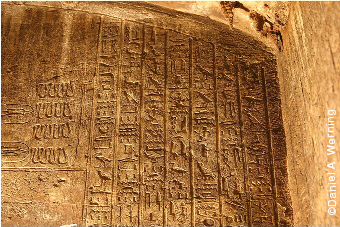In this research project, Daniel Werning investigated the diagrammatic representation of the Ancient Egyptian underworld as attested in the Book of Caverns, an Egyptian Netherworld Book from the 13th century BCE.
Research
Research object
Three great Ancient Egyptian Netherworld Books from the 2nd half of the 2nd millennium BCE each consist of images and accompanying texts which were arranged in a table-like fashion, forming a diagrammatic representation of the underworld.
(Click to enlarge) Schema of the Ancient Egyptian Netherworld Book ‘Book of Caverns’ | Daniel A. Werning | CC BY-SA 3.0
Originally, these books were pieces of knowledge literature (Eg. rḫ ‘knowing’) which contained the ideas of the Ancient Egyptian theologians about the sun god’s journey from the western to the eastern horizon through the underworld, his transformation and especially his interaction with the inhabitants of the underworld. This knowledge was also the background for nightly rituals and liturgies that were executed during the night by priests in order to support the sun god’s journey.
The latest of the three Great Netherworld Books, the Book of Caverns was composed in the 13th century BCE. Like its two predecessors, it does not represent the ideas about the topographical structure of the underworld in form of a topographical map, but rather in a table-like diagrammatic form. Caverns, however, seems to represent much more structural features of the imagined underworld topography than its predecessors.
Results
In this research project, Daniel Werning investigated these diagrammatic representations as topology-related and time-related diagrams as well as the underlying topological and topographical concepts as laid out in the accompanying texts. The result is a set of hypotheses on the ancient ideas about the topology and topography of the netherworld and the sun god’s path through it. These hypotheses are presented in the form of (modern) topological diagrams as well as in the form of modern ground plans and front elevations, respectively. Furthermore, the diagrammatic forms of the Netherworld Books is looked at from the perspective of graphic novel studies. It is argued that we find arrangements of panels and distributions of actors similar to those in modern graphic novels. Publications:
Daniel A. Werning, “The Representation of Space, Time, and Event Sequence in an Ancient Egyptian Netherworld Comic”, in: Gaëlle Chantrain and Jean Winand (Eds.), Time and Space at Issue in Ancient Egypt, Hamburg: Kai Widmaier, 2018, 209–242
Daniel A. Werning, “Der mythische Stoff des Sonnenaufgangs in ägyptischen Texten und Bildern des 15.–10. Jahrhunderts v.Chr”, in: Annette Zgoll and Christian Zgoll (Eds.), Mythische Sphärenwechsel. Methodisch neue Zugänge zu Mythen aus Sumer und Akkad, Ägypten, Hatti und Hurri, Israel, Griechenland, Rom und frühem Christentum, Berlin, Boston: De Gruyter, [in press]

The ‘Book of Caverns’ in tomb TT 33 (room XVII, south wall) | Photo: Daniel A. Werning | © Daniel A. Werning
As part of the project, Daniel Werning also joined the Mission épigraphique française dans la tombe de Padiaménopé, headed by Claude Traunecker (Strasbourg) and Isabelle Regen (Montpellier), the goal of which is the publication of the decoration of the unpublished tomb of the Chief Lector Priest Petamenophis (TT33) in Luxor (Egypt) from the 7th cent. BCE. The publication of the Book of Caverns in this tomb encompasses the hieroglyphic text (ca. 150 pages) as well as outline drawings of the eight walls including the ca. 80 scenes, and detailed photos of the respective parts of the walls. This text witness of Caverns is one of only three complete attestations of the text. Publications:
Daniel A. Werning, The Book of Caverns in Theban Tomb 33: Arbeitsphotos, 2018, Berlin: Edition Topoi, DOI: 10.17171/2-8
Daniel A. Werning, Das Höhlenbuch im Grab des Petamenophis (TT33): Szenen, Texte, Wandtafeln, 2019, Berlin: Edition Topoi
Student Assistants working for the project: Antonio Cantele (2016-2018), Theresa Annacker (2018).
